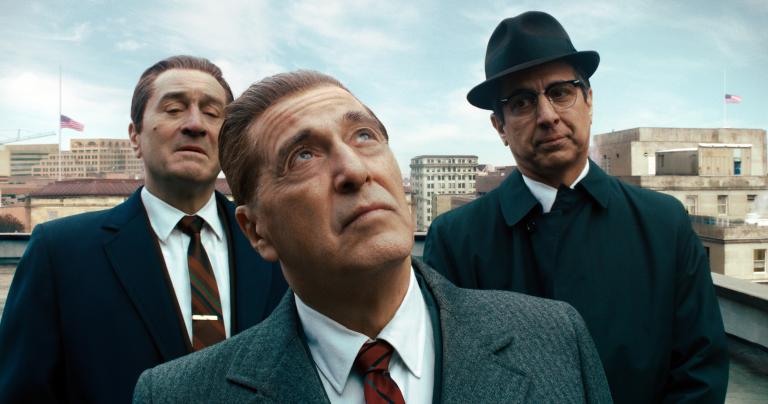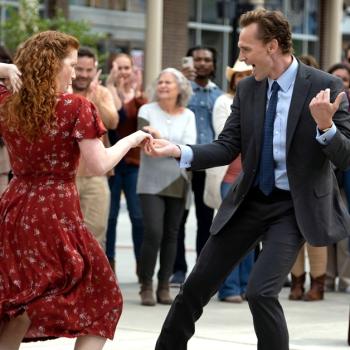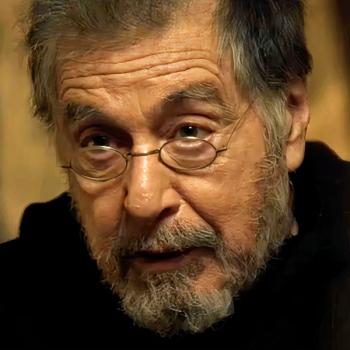
Producer/director Martin Scorsese’s gangster epic-ally long The Irishman on Netflix has been the recipient of many glowing reviews and a 96% critical rating on Rotten Tomatoes. So, I decided to watch it today. Clocking in at 3:30, it took up most of the afternoon, but didn’t occupy, nor merit, a commensurate share of my attention.
I’ll watch pretty much anything Joe Pesci is in, and I’ve watched and loved many a gangster movie. I was so hoping for the pop and crackle of one of them, Casino, in which Pesci also starred with Robert DeNiro. Despite the discharge of many guns, The Irishman had a distinct lack of pop and zero crackle. It a ponderous, lollygagging affair, lacking the verve of The Godfather, the style of The Untouchables, or the humor of The Sopranos.
Based on Charles Brandt’s 2004 book I Heard You Paint Houses , it’s the fact-inspired story of World War II veteran, truck driver and mob hitman Frank “The Irishman” Sheeran, his mob mentor Russell Bufalino (Joe Pesci), Teamster lawyer Bill Bufalino (a barely recognizable Ray Romano) and Sheeran’s friendship with legendarily missing Teamster boss Jimmy Hoffa (Al Pacino) — more on the real-life characters here.
The film is in theaters and streaming on Netflix. I can’t imagine watching it in a theater, unless it had recliners, I was incredibly motivated and was consuming mass quantities of caffeine. At home, fortunately, I could take breaks to do laundry.
I was going to write a review, but honestly, I can’t do better than my script consultant and friend Sara Anne Fox’s review, which she posted on Facebook. So, with her kind permission:
The Irishman on Netflix. Outside of Joe Pesci’s brilliant performance in the best-written role in this endless 3.5 hour, mostly pointless saga, it’s an attenuated mess.
Much has been made of the de-aging technology, but it’s ultimately meaningless. They may have removed many of the lines and wrinkles from De Niro’s face, but that unpleasant down-turned mouth and suspicious, beady eyes can’t be fixed. De Niro at 44 in real life was the one seen in Midnight Run – still good-looking, vital and attractive. De Niro at 44 in this film is 75 with fewer crevices in his face, that’s all. Pacino fared better in the “magic of technology” department; and Pesci was just a wonderful conglomeration of advancing age in different stages in every scene he was in. And in the end, it couldn’t save the film.
De Niro, as the Irishman, had little or no inner life. His performance was one note, with the exception of a second note in a scene where he takes revenge on a grocer who had shoved his young daughter in his store. He hems and haws when he’s with mob characters, who have more personality in 30-second scenes than he does in the whole movie. Meanwhile, Pesci’s character, a warm, canny and very powerful father figure. acts rings around him.
Pacino fares better as he wears the cloak of the memory of Jack Nicholson’s terrific limning of Teamster boss Jimmy Hoffa in 1992’s Hoffa. Pacino is much better than De Niro because he makes the attempt to give his character some depth and personality. “Because it’s my union!” We get it. Along with Pesci, he’s the most fully-formed character in the film. And that leads us to the writing…
De Niro makes decisions from the very beginning of the movie that are never explained or explored in any kind of meaningful way to the audience. The script, written by Steven Zaillian, glosses over a choice he makes regarding his marriage and children, and we never know why he did this. Oh, we can guess, but we don’t get any emotional response or comment from him in the voiceover. There’s a scene that’s supposed to be moving towards the end of the movie with one of his grown daughters. but it feels contrived. because we have barely seen him interact with any of his kids, save one. Our hearts are supposed to break for this man. and they are as hard and cold as stone.
There’s a brief reference in the beginning to a situation Frank found himself in when he was a soldier during WWII. In the book that the movie is based on, it was much worse and was a key to his character. The movie throws the scene at us and then proceeds to have De Niro move from scene to scene, passive and agreeable. There is a montage of him shooting people at the behest of the powers-that-be, but it’s icing on a very stale, old cake. Harvey Keitel and Bobby Cannavale in minor but indelible roles are sorely missed because when they’re onscreen, we’re mesmerized.
Aaaand… The interminable scenes that go on and on and on. Sometimes repetition between characters is necessary, but Scorsese overdoes it. There’s a curious lack of energy in this movie, and energy is one of the hallmarks of Scorsese’s work. He assumes we are as interested in peripheral characters as he is, and he allows De Niro to give us a boring, monotone-like voiceover that does little to make the goings-on more compelling. Remember Scorsese bursting on the scene with his second film, Mean Streets? It had brilliant energy to burn and a deep understanding of its characters and their motives and actions.
Scorcese is fascinated and in love with the machinations of the fraternity of men, especially those who live a life of thumbing their nose at the law and society’s rule, as they enrich themselves with power and money. It IS a compelling subject. But he’s done it so much better in the many films he has made dealing with the subject.
The men in The Irishman have women in their lives, but the female characters are barely there. That’s OK, I’m not a raging feminist demanding diversity and equality and all that. But it would have been interesting to know more about these women, these wives and daughters, if only to round out the characters of their men. The exception is Jo Hoffa (Welker White), married to Jimmy. We get a clear picture of their relationship and family and keenly feel her deep despair when her husband goes missing.
The Irishman — It’s as if Goodfellas and Casino had a baby that did neither parent any credit.
Sara Anne Fox (official site here) is a former feature film development executive who works as a story editor with her writing clients, passionately advocating for their material. She deals not only with screenwriters but with novel and memoir authors as well. Ms. Fox also lectures on screenwriting in college classes and runs workshops and seminars on all aspects of the genre. Martin Scorsese’s Mean Streets is in the top five of her very favorite films.
I will say, though, that it was lovely to see these grand old lions of America cinema — Pesci and De Niro are 76, and Pacino is 79 — doing their thing, in a genre each has dominated. It’s a shame that The Irishman isn’t quite up to the standard of its predecessors, but it did get me thinking of the awful hole that will be left when any of them either retires (which doesn’t seem likely at this point) or meets his eternal reward.
Oh, and priest Jonathan Morris (he’s requested to be laicized, but it hasn’t been granted yet) plays a priest in this (apparently Fr. James Martin also makes a cameo, but the less said about that, the better). Not sure if he was still a priest when he shot it, and sure hope it doesn’t mean he’s seeking an acting career (although his line readings were pretty good, for an amateur). His prayerful last scenes with Sheeran — along with another scene featuring the elderly Russ as he jaunts off to church shortly before his death — are a reminder that, with repentance, forgiveness is available for all. And that means all, even murderous mob bosses and hitmen.
The Irishman is rated R for language and violence (there’s a surprising lack of sex, but considering the age of the male leads, probably a wise move).
Image: Netflix
Don’t miss a thing: Subscribe to all that I write at Authory.com/KateOHare














